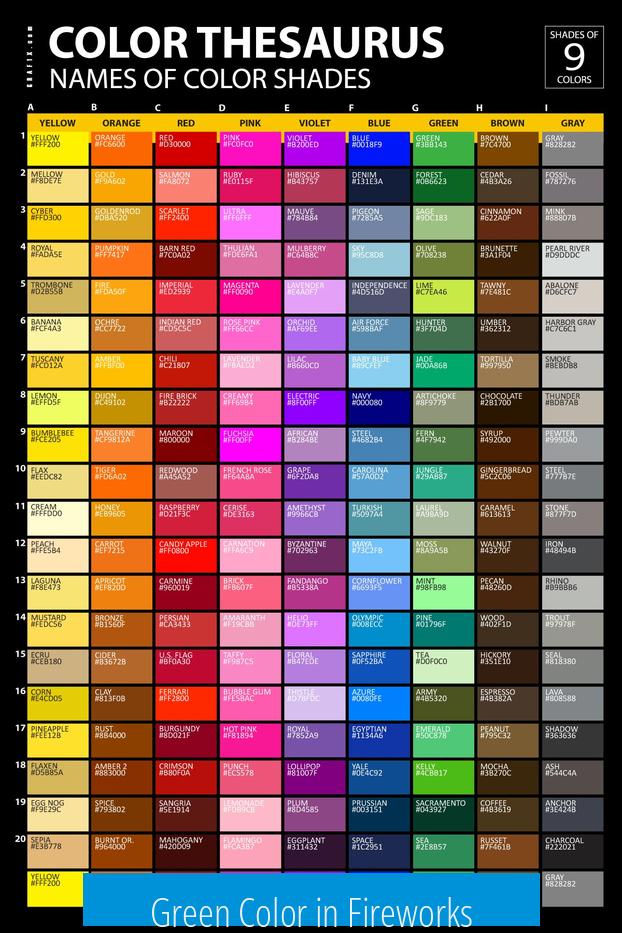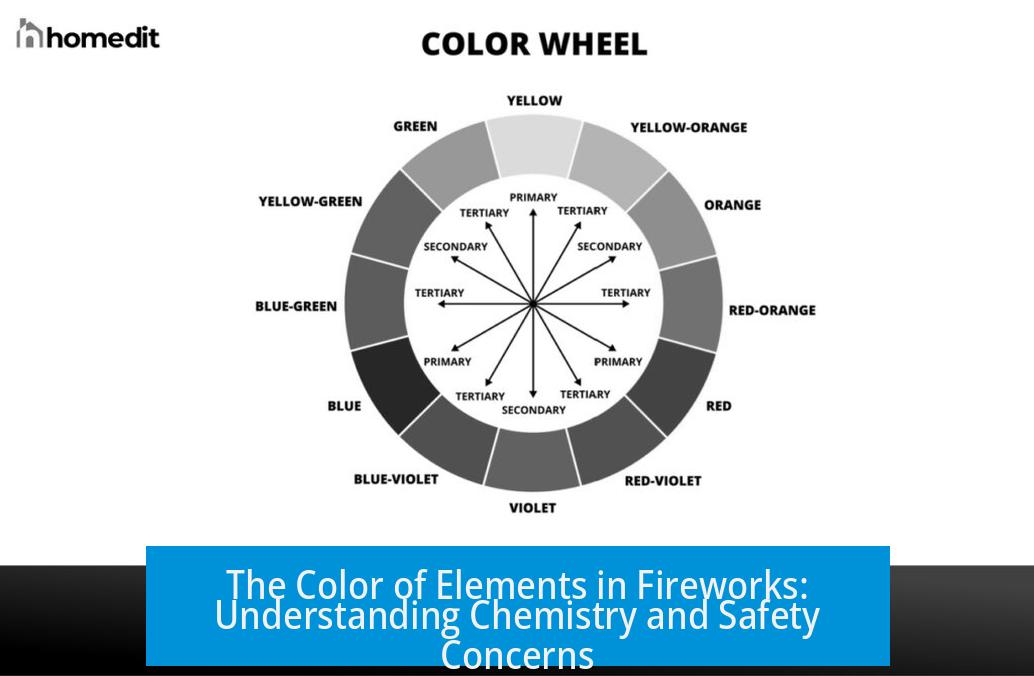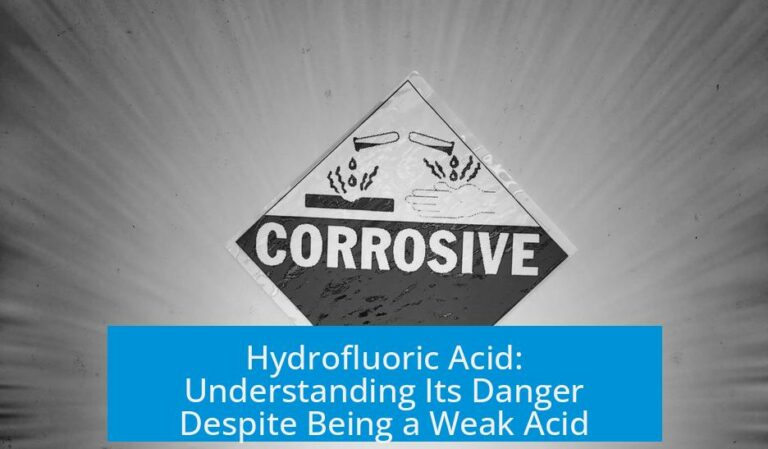The Color of Elements in Fireworks

The color in fireworks depends on specific elements burned during the explosion. Each element emits characteristic colors when heated, creating the vibrant displays seen in pyrotechnics. The chemistry behind these colors involves electron excitation and emission at precise wavelengths.
Green Color in Fireworks

Barium is the key element generating green hues in fireworks. When barium compounds burn, they emit green light. However, barium is toxic and presents health hazards both in production and environmental exposure. The green color is often difficult to produce consistently due to this toxicity and the need for careful handling.
Challenges Producing Blue and Green Colors
- Blue and green colors require lower flame temperatures for proper emission.
- High heat from explosions can alter or overpower blue and green spectral lines.
- Pyrotechnicians use compounds and cooling agents to stabilize these colors.
For example, copper compounds yield blue colors but must be combined with cooling agents to prevent the flame from becoming too hot. Controlling combustion temperature is critical for achieving pure blue and vibrant green shades.
Purple Color in Fireworks
Purple results from mixing red and blue colors. This blend creates a purple appearance distinct from violet, which corresponds to a single spectral wavelength.
Lithium compounds can contribute to reddish tones used in creating purple mixtures. By adjusting ratios of blue copper and red lithium components, pyrotechnicians achieve a balanced purple.
Orange and Other Colors
Orange color is primarily from sodium emissions, not calcium. Sodium produces a strong orange-yellow flame. Calcium can produce an orange-red color but is less intense than sodium’s bright orange.
Uranium and Fireworks
Uranium is not used in fireworks due to its radioactive nature and hazardous health risks. Questions about uranium arise from misunderstanding its role in explosive or luminous effects. Fireworks rely on safer metallic salts for color creation.
General Chemistry of Firework Colors
- Colors arise when elements’ electrons are excited by high temperatures.
- Excited electrons emit light at characteristic wavelengths when returning to ground state.
- The emitted light creates the distinct color seen in the sky.
Safety and Health Concerns
Fireworks release smoke containing metal compounds and particulate matter. Avoid inhaling this smoke as it may contain toxic substances, including barium compounds. Spectators should maintain distance to minimize exposure.
Key Takeaways
- Barium causes green colors; it’s toxic and requires careful handling.
- Blue and green colors need controlled flame temperatures for purity.
- Purple is a mix of red (lithium) and blue (copper) emissions.
- Orange derives mainly from sodium, not calcium.
- Uranium is not used in fireworks due to safety hazards.
- Colors result from electron excitations emitting light at set wavelengths.
- Fireworks smoke can be harmful; avoid breathing it in.
The Color of Elements in Fireworks: A Bright Chemistry Lesson
Why do fireworks paint the night sky with such vivid colors? Because specific elements burn to emit distinct hues. Each color in fireworks, from green to purple, owes its gorgeous glow to a chemical guest star. This post unpacks how these elements work their magic, explores some tricky colors to produce, and even clears up misconceptions about fireworks’ color chemistry. Ready for a dazzling deep dive?
Green Fireworks: The Barium Beat
Green hues in fireworks come from barium. Yes, the element often talked about in chemistry class shows off splendidly in pyrotechnics. When barium salts combust, they emit a bright green light that’s hard to miss. However, barium is a bit of a diva—it also brings significant health hazards. So while it dazzles, it also demands respect and careful handling.
Fun fact: Some fireworks deliberately avoid barium to dodge health risks, which can lead to less vibrant green shades or no green at all. This explains why some green firework effects aren’t as brilliant as others.
Why Are Blue and Green Colors So Tricky?
Ever wonder why blue and green fireworks are rarer and historically tougher to produce? It’s all about heat. The explosion inside a firework shell burns at incredibly high temperatures, which can interfere with the delicate emission of blue and green light. Blue especially is the “most difficult” because the excited atoms needed for blue light don’t thrive in intense heat.
Mostly, chemists solve this by tailoring the firework’s composition. They choose *cooler-burning* compounds that don’t overpower the blue-green color signals. They also engineer the timing so different compounds ignite in sequences, allowing blue and green to shine through.
The Purple Puzzle: Mixing Red and Blue
Purple fireworks often cause a bit of confusion. Some might say “purple” and “violet” interchangeably, but chemistry begs to differ. Purple is a combo color—red plus blue. Violet is a true single wavelength visible light discovered in the rainbow spectrum. So the brilliant purple seen in fireworks is usually a result of combining fireworks chemicals that produce red and blue light simultaneously.
Lithium salts, often used for red colors, might chip in here. Some pyrotechnic formulas include lithium to deepen the red tones, which, when mixed with blue-emitting compounds, create that rich purple glow.
Orange Fireworks: Sodium or Calcium?
Identification of the element responsible for orange fireworks causes some debate. Sodium is known for bright yellow colors. Calcium, on the other hand, produces brick-red to orange hues. The confusion is understandable. Sodium’s flame test yields yellow but in fireworks, small additions of calcium compounds often push the tone toward orange.
In practice, pyrotechnicists might use a combo of both to achieve the desired orange brightness and stability. So don’t be surprised to find both elements in orange firework formulations.
Uranium and Fireworks? The Mystery Answer
People often wonder about uranium’s role in fireworks. The answer: uranium has no place in typical fireworks. It’s radioactive, dangerous, and not exactly the best candidate for a family-friendly pyrotechnic show.
That “mushroom cloud” comment? It’s a jest more than chemistry. Fireworks rely on safer metal salts for their colors. Uranium’s radioactive glow is not only unsafe but unnecessary when better, non-radioactive options perform the job.
General Chemistry Behind Firework Colors
Remember that chemistry lab where burning different elements made colorful flames? Fireworks take that principle to the extreme. Each metal atom, when heated, has electrons jumping to higher energy levels. When the electrons fall back down, they release energy as light of a specific color.
For example:
- Sodium: Yellow
- Strontium: Red
- Copper: Blue/green
- Barium: Green
- Lithium: Red/orange hues
Manipulating which elements burn and how hot they get creates a palette of colors streaking across the sky. It’s basic, but beautiful chemistry in action.
Safety Matters: Avoid Breathing Fireworks Smoke
Fireworks emit all sorts of fine particulate matter and metals when they explode. The colorful sparks aren’t the only things traveling through the air—harmful smoke comes along for the ride. This is why experts warn not to breathe in the smoke directly. Even after the show ends, lingering particles can be inhaled.
So, the best practice is to enjoy fireworks at a safe distance, avoid smoky areas, and if you’re handling pyrotechnics yourself (never recommended without training), use proper protection. Bright colors are fun, but your lungs deserve care.
Wrapping Up: Why Knowing the Color Chemistry of Fireworks Matters
Next time you watch a fireworks display, you’re witnessing carefully choreographed chemistry. Each brilliant streak owes its hue to elements working hard under extreme heat. Barium offers green sparkle but with health risks. Blue and green require special tricks due to temperature challenges. Purple arrives as a blend of red and blue, sometimes aided by lithium. And uranium? It’s just a fireworks myth.
By understanding the elements behind each color, viewers appreciate not just the beauty but the science making every burst possible. Plus, knowing the toxic nature of some components reminds us to respect safety advice and enjoy the spectacle responsibly.
So, what’s your favorite firework color and the element behind it? Share your thoughts or any fiery chemistry questions you have!
What element produces green color in fireworks?
Barium is the element responsible for the green color in fireworks. It is widely used despite posing health risks due to its toxicity when burned.
Why is it difficult to produce blue and green colors in fireworks?
Blue and green colors require precise temperature control. The intense heat of the explosion often alters the colors, making it hard to maintain the pure hues.
How is purple color created in fireworks?
Purple is made by mixing red and blue colors. Lithium can sometimes be used, but purple itself is a blend rather than a single pure color.
Which element creates the orange color in fireworks?
Orange is typically produced using calcium compounds, though some confuse it with sodium. Sodium mainly yields yellow colors.
Is uranium used in fireworks to produce color?
Uranium is not used in fireworks. Its radioactive nature makes it unsuitable for color production in pyrotechnics.





Leave a Comment